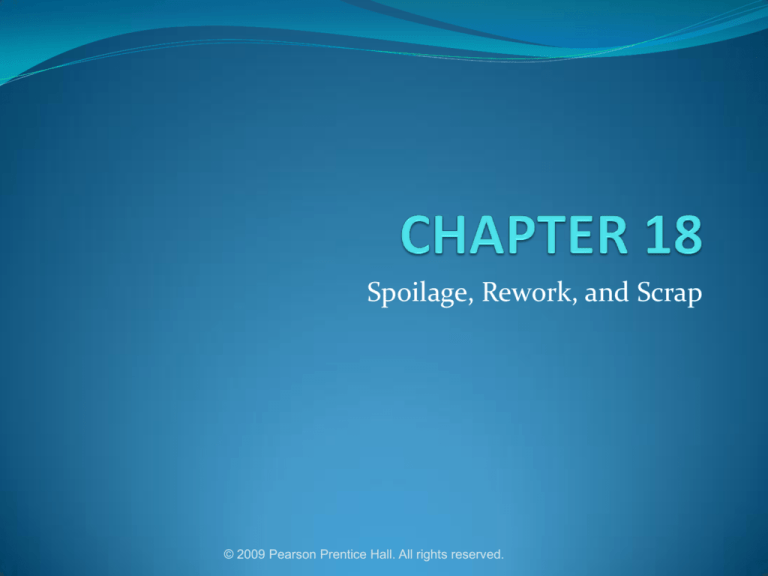
Spoilage, Rework, and Scrap
© 2009 Pearson Prentice Hall. All rights reserved.
Basic Terminology
Spoilage – units of production, either fully or partially
completed, that do not meet the specifications
required by customers for good units and that are
discarded or sold for reduced prices
© 2009 Pearson Prentice Hall. All rights reserved.
Basic Terminology
Rework – units of production that do not meet the
specifications required by customers but which are
subsequently repaired and sold as good finished goods
Scrap – residual material that results from
manufacturing a product. Scrap has low total sales
value compared with the total sales value of the
product
© 2009 Pearson Prentice Hall. All rights reserved.
Accounting for Spoilage
Accounting for spoilage aims to determine the
magnitude of spoilage costs and to distinguish
between costs of normal and abnormal spoilage
To manage, control and reduce spoilage costs, they
should be highlighted, not simply folded into
production costs
© 2009 Pearson Prentice Hall. All rights reserved.
Types of Spoilage
Normal Spoilage – is spoilage inherent in a particular
production process that arises under efficient
operating conditions
Management determines the normal spoilage rate
Costs of normal spoilage are typically included as a
component of the costs of good units manufactured
because good units cannot be made without also making
some units that are spoiled
© 2009 Pearson Prentice Hall. All rights reserved.
Types of Spoilage
Abnormal Spoilage – is spoilage that is not inherent
in a particular production process and would not
arise under normal operating conditions
Abnormal spoilage is considered avoidable and controllable
Units of abnormal spoilage are calculated and recorded in the
Loss from Abnormal Spoilage account, which appears as a
separate line item no the income statement
© 2009 Pearson Prentice Hall. All rights reserved.
Process Costing and Spoilage
Units of Normal Spoilage can be counted or not
counted when computing output units (physical or
equivalent) in a process costing system
Counting all spoilage is considered preferable
© 2009 Pearson Prentice Hall. All rights reserved.
Inspection Points and Spoilage
Inspection Point – the stage of the production process
at which products are examined to determine whether
they are acceptable or unacceptable units.
Spoilage is typically assumed to occur at the stage of
completion where inspection takes place
© 2009 Pearson Prentice Hall. All rights reserved.
The Five-Step Procedure for Process Costing
with Spoilage
Step 1: Summarize the flow of Physical Units of
Output – identify both normal and abnormal spoilage
Step 2: Compute Output in Terms of Equivalent Units.
Spoiled units are included in the computation of
output units
© 2009 Pearson Prentice Hall. All rights reserved.
The Five-Step Procedure for Process Costing
with Spoilage
Step 3: Compute Cost per Equivalent Unit
Step 4: Summarize Total Costs to Account For
Step 5: Assign Total Costs to:
Units Completed
2. Spoiled Units
3. Units in Ending Work in Process
1.
© 2009 Pearson Prentice Hall. All rights reserved.
Steps 1 & 2 Illustrated
© 2009 Pearson Prentice Hall. All rights reserved.
Steps 3, 4 & 5 Illustrated
© 2009 Pearson Prentice Hall. All rights reserved.
Steps 1 & 2, Illustrated
© 2009 Pearson Prentice Hall. All rights reserved.
Steps 3, 4 & 5, Illustrated
© 2009 Pearson Prentice Hall. All rights reserved.
Steps 1 & 2, Illustrated
© 2009 Pearson Prentice Hall. All rights reserved.
Steps 3, 4 & 5, Illustrated
© 2009 Pearson Prentice Hall. All rights reserved.
Job Costing and Spoilage
Job costing systems generally distinguish between
normal spoilage attributable to a specific job from
normal spoilage common to all jobs
© 2009 Pearson Prentice Hall. All rights reserved.
Job Costing and
Accounting for Spoilage
Normal Spoilage Attributable to a Specific Job: When
normal spoilage occurs because of the specifications of
a particular job, that job bears the cost of the spoilage
minus the disposal value of the spoilage
© 2009 Pearson Prentice Hall. All rights reserved.
Job Costing and
Accounting for Spoilage
Normal Spoilage Common to all Jobs: IN some cases,
spoilage may be considered a normal characteristic of
the production process.
The spoilage is costed as manufacturing overhead
because it is common to all jobs
The Budgeted Manufacturing Overhead Rate includes a
provision for normal spoilage
© 2009 Pearson Prentice Hall. All rights reserved.
Job Costing and
Accounting for Spoilage
Abnormal Spoilage: If the spoilage is abnormal, the
net loss is charged to the Loss From Abnormal
Spoilage account
Abnormal spoilage costs are not included as a part of the
cost of good units produced
© 2009 Pearson Prentice Hall. All rights reserved.
Job Costing and Rework
Three types of rework:
Normal rework attributable to a specific job – the
rework costs are charged to that job
2. Normal rework common to all jobs – the costs are
charged to manufacturing overhead and spread,
through overhead allocation, over all jobs
3. Abnormal rework – is charged to the Loss from
Abnormal Rework account that appears on the
income statement
1.
© 2009 Pearson Prentice Hall. All rights reserved.
Accounting for Scrap
No distinction is made between normal and abnormal
scrap because no cost is assigned to scrap
The only distinction made is between scrap
attributable to a specific job and scrap common to all
jobs
© 2009 Pearson Prentice Hall. All rights reserved.
Aspects of Accounting for Scrap
1.
2.
Planning & Control, including physical tracking
Inventory costing, including when and how it affects
operating income
NOTE: Many firms maintain a distinct
account for scrap costs
© 2009 Pearson Prentice Hall. All rights reserved.
Accounting for Scrap
Scrap Attributable to a Specific Job – job costing
systems sometime trace the scrap revenues to the jobs
that yielded the scrap.
Done only when the tracing can be done in an economic
feasible way
No cost assigned to scrap
© 2009 Pearson Prentice Hall. All rights reserved.
Accounting for Scrap
Scrap Common to all Jobs – all products bear
production costs without any credit for scrap revenues
except in an indirect manner
Expected scrap revenues are considered when setting is
lower than it would be if the overhead budget had not
been reduced by expected scrap revenues
© 2009 Pearson Prentice Hall. All rights reserved.
Accounting for Scrap
Recognizing Scrap at the Time of its Production –
sometimes the value of the scrap is material, and the
time between storing and selling it can be long
The firm assigns an inventory cost to scrap at a
conservative estimate of its net realizable value so that
production costs and related scrap revenues are
recognized in the same accounting period
© 2009 Pearson Prentice Hall. All rights reserved.
© 2009 Pearson Prentice Hall. All rights reserved.

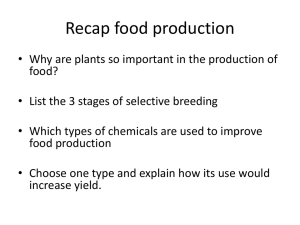
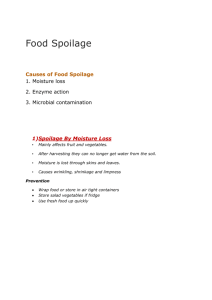

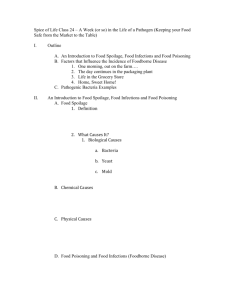
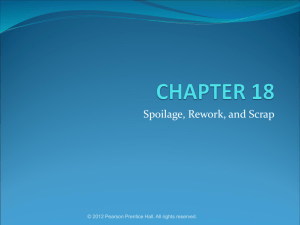
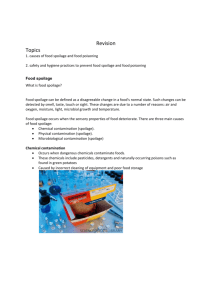
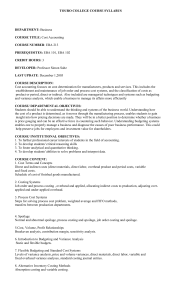
![You`re invited to celebrate [child`s name]`s birthday at SCRAP! What](http://s3.studylib.net/store/data/007177272_1-c15601fb9e11b26854f13f1982e634e8-300x300.png)